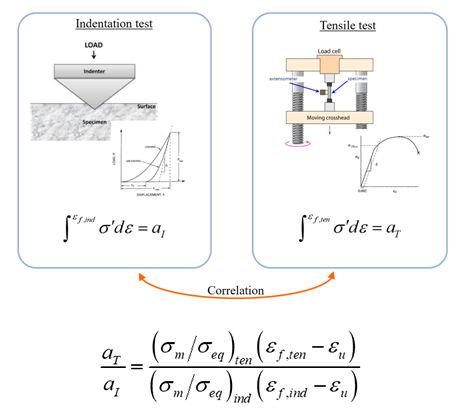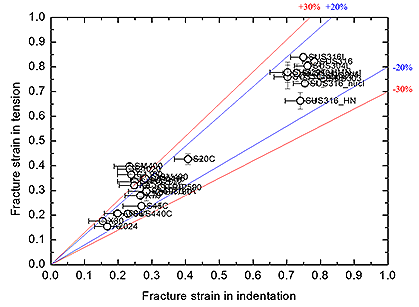Resources
Technology
Resources
Fracture Strain
Fracture strain evaluation is essential for predicting material failure, especially for materials that undergo significant plastic deformation before fracture. The deformation behavior in tensile and indentation tests shows similar patterns leading up to fracture.
By comparing the plastic energy required for fracture during tensile and indentation testing, the Instrumented Indentation Test (IIT) can measure fracture strain under various load conditions. This allows for the identification of the critical strain condition at which a material can no longer withstand deformation without failing.
Figure 1. Correlation of critical plastic energy between indentation and tensile tests.

One approach to predicting ductile fracture is the concept that fracture occurs when the accumulated plastic deformation energy reaches a critical threshold. Stress triaxiality, in particular, influences pore formation and growth, which in turn affects energy absorption and fracture behavior. By incorporating this stress triaxiality into the critical plastic energy criterion, accurate fracture predictions can be made under various loading conditions.
In indentation tests, when stress triaxiality reaches saturation, it indicates the critical point of fracture, where no further deformation is possible. At this saturation point, plastic deformation stabilizes, providing a reference for fracture strain.
Figure 2. Saturation of stress triaxiality during indentation testing.

In indentation tests, a complex multiaxial stress state is formed, causing compressive stress beneath the indenter and tensile stress at the edges. Although the stress states differ, the same material requires similar amount ofcritical plastic energy to fracture in both tensile and indentation tests. By using IIT data, fracture strain in tensile tests can be predicted.
During indentation, stress triaxiality is determined by local deformation resistance and surface hardness. The point at which the triaxial stress state reaches saturationindicates a condition where only stress increases without additional deformation, representing the critical state of fracture. This allows for a systematic analysis of the stress-strain response and fracture stress state for different materials.
The multiaxial stress state in indentation tests causes greater plastic constraint than the uniaxial stress state in tensile tests, increasing the effective stress required for deformation. The Plastic Constraining Factor (PCF) is an index used to compare the plastic deformation characteristics between indentation and tensile tests. Based on data obtained from indentation tests, it is possible to assess a material’s resistance to fracture.
The fracture strain values evaluated through tensile and indentation tests show a linear proportional correlationfor various materials, maintaining consistency within a ±30% error range. This means that fracture strain in tensile tests can be predicted based on data obtained from Instrumented Indentation Tests.
Figure 3. Comparison of fracture strain between tensile and indentation tests.


 Directions
Directions


